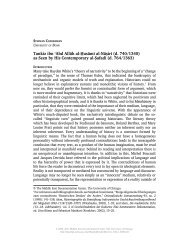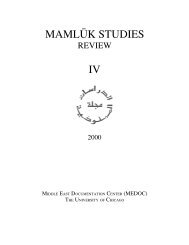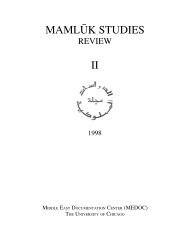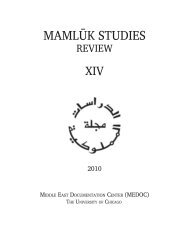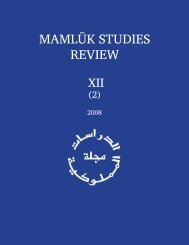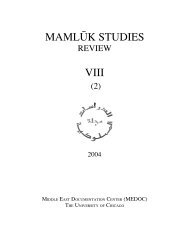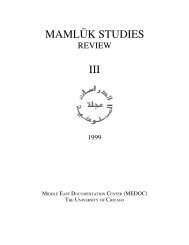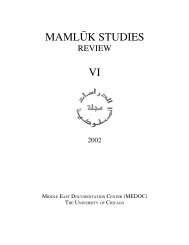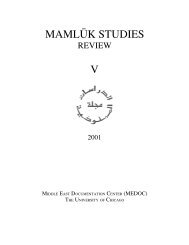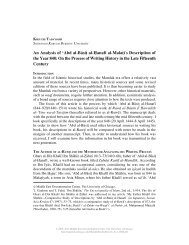Vol. VII, no. 1 (2003) - Mamluk Studies Review - University of Chicago
Vol. VII, no. 1 (2003) - Mamluk Studies Review - University of Chicago
Vol. VII, no. 1 (2003) - Mamluk Studies Review - University of Chicago
Create successful ePaper yourself
Turn your PDF publications into a flip-book with our unique Google optimized e-Paper software.
MAMLU±K STUDIES REVIEW VOL. 7, <strong>2003</strong> 25<br />
ranks, <strong>of</strong>fices, and crafts in <strong>Mamluk</strong> Egypt. "Be as the corpse in the hands <strong>of</strong> the<br />
washer" was the book's quietist, Sufi burden.<br />
A considerable quantity <strong>of</strong> edifying uncontroversial Sufi literature was produced<br />
in this period, mostly in the form <strong>of</strong> poems, sermons, or short biographies <strong>of</strong> Sufi<br />
holy men. Ibn Ab| H˛ajalah wrote Sufi poetry. ‘Abd Alla≠h ibn Asad al-Ya≠fi‘| (ca.<br />
700–ca. 768/1299–1367) compiled Rawd˝ al-Riya≠h˝|n f| H˛ika≠ya≠t al-S˛a≠lih˝|n, which<br />
contained the biographies <strong>of</strong> over five hundred Sufis. His collection was later<br />
drawn upon by al-Ibsh|h| and by the a<strong>no</strong>nymous continuators <strong>of</strong> the Arabian<br />
Nights. The Sha≠dhil| Sufi Ah˝mad ibn Muh˝ammad Ibn ‘At¸a≠ Alla≠h (d. 709/1309)<br />
produced collections <strong>of</strong> spiritual aphorisms and sermons. Both al-Ya≠fi‘| and Ibn<br />
‘At¸a≠ Alla≠h were implacable opponents <strong>of</strong> Ibn Taym|yah. 71 However, the most<br />
heated debates throughout the whole <strong>Mamluk</strong> period concerned the disputed<br />
orthodoxy <strong>of</strong> two Sufis <strong>of</strong> the pre-<strong>Mamluk</strong> period, Sharaf a-D|n ‘Umar Ibn al-Fa≠rid˝<br />
(576–632/1181–1235) and Muh˝y| al-D|n Ibn ‘Arab| (560–638/1165–1240). Fierce<br />
debates raged about the meaning <strong>of</strong> their poetic output and about whether it was<br />
legitimate to use apparently blasphemous metaphors in order to express holy<br />
things. Ibn al-‘Arab| and Ibn al-Fa≠rid˝ avoided <strong>of</strong>ficial condemnation, and Ibn<br />
al-Fa≠rid˝'s verses in the bad|‘ manner were widely imitated by poets <strong>of</strong> the <strong>Mamluk</strong><br />
age. 72 Even so, al-Dhahab| declared that Ibn al-Fa≠rid˝'s writings were "pastry laced<br />
with ve<strong>no</strong>m." Other distinguished hostile critics included Ibn Ab| H˛ajalah, Ibn<br />
Khaldu≠n, and Ibn H˛ajar.<br />
A student <strong>of</strong> Ibn H˛ajar's, Burha≠n al-D|n Ibra≠h|m al-Biqa≠‘| ibn ‘Umar (ca.<br />
809–85/ca. 1407–80) was perhaps the most interesting and certainly the most<br />
ve<strong>no</strong>mous <strong>of</strong> the critics <strong>of</strong> the two famous Sufi poets. Al-Biqa≠‘| can be considered<br />
as a writer as man <strong>of</strong> action, since he participated in <strong>Mamluk</strong> raids against Cyprus<br />
and Rhodes. He was a stylish and embittered author who wrote on a great range <strong>of</strong><br />
subjects, including hadith, history, biography, famous lovers, and mathematics.<br />
Given the <strong>Mamluk</strong> court's tendency to look kindly on Sufism, his onslaught on<br />
monism and other alleged Sufi excesses was doomed, and he died in disgrace in<br />
Damascus. Since <strong>no</strong> one else was likely to, he had written his own eulogy. 73<br />
71 On Sufism in the <strong>Mamluk</strong> period, see Annemarie Schimmel, "Sufismus and Heiligeverehrung<br />
im spätmittelalterlichen Ägypten," in Festschrift Werner Caskel zum siebzigsten Geburtstag 5.<br />
März 1966 gewidmet von Freunden und Schülern, ed. Erwin Graf (Leiden, 1968), 274–89; Donald<br />
P. Little, "Religion under the <strong>Mamluk</strong>s," The Muslim World 73 (1983): 165–81; Leo<strong>no</strong>r E. Fernandes,<br />
The Evolution <strong>of</strong> a Sufi Institution in <strong>Mamluk</strong> Egypt: The Khanqah (Berlin, 1988).<br />
72 Th. Emil Homerin, From Arab Poet to Muslim Saint: Ibn al-Fa≠rid˝, His Verse, and His Shrine<br />
(Columbia, S.C., 1994), 55–75; Knysh, Ibn ‘Arab|, 49–140, 201–23; Michael Winter, Society and<br />
Religion in Early Ottoman Egypt (New Brunswick, N.J., 1982), 160–65.<br />
73 Giffen, Theory <strong>of</strong> Pr<strong>of</strong>ane Love, 41–42; Homerin, From Arab Poet to Muslim Saint, 62–75;<br />
Knysh, Ibn ‘Arab|, 209–23; Li Guo, "Al-Biqa≠’|'s Chronicle: A Fifteenth Century Learned Man's<br />
Reflection on His Time and World," in Kennedy, The Historiography <strong>of</strong> Islamic Egypt, 121–48.<br />
© <strong>2003</strong>, 2012 Middle East Documentation Center, The <strong>University</strong> <strong>of</strong> <strong>Chicago</strong>.<br />
http://mamluk.uchicago.edu/<strong>Mamluk</strong><strong>Studies</strong><strong>Review</strong>_<strong>VII</strong>-1_<strong>2003</strong>.pdf



